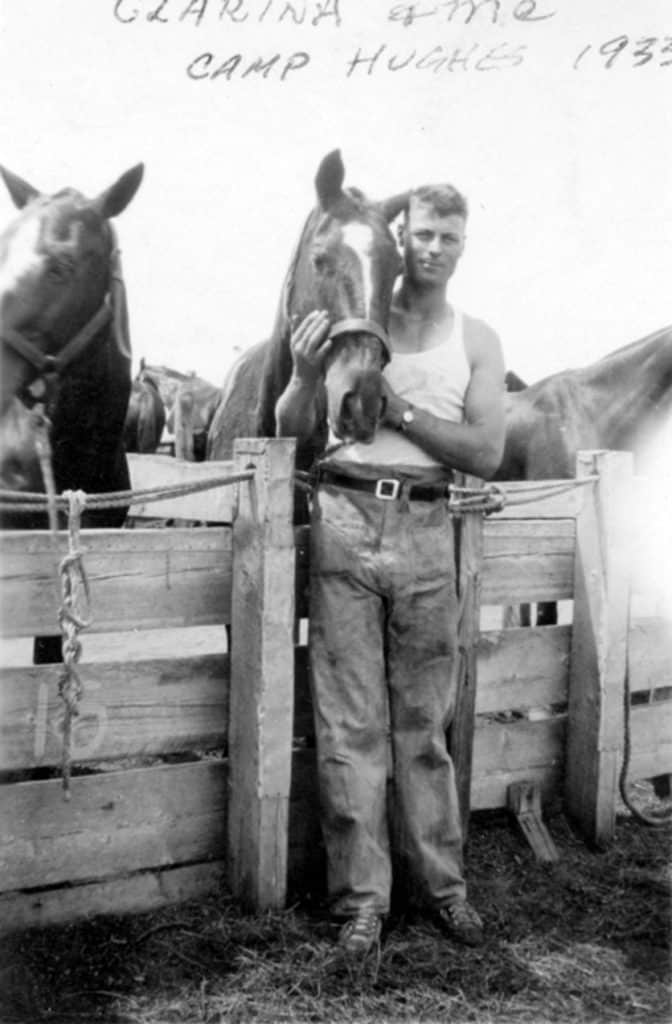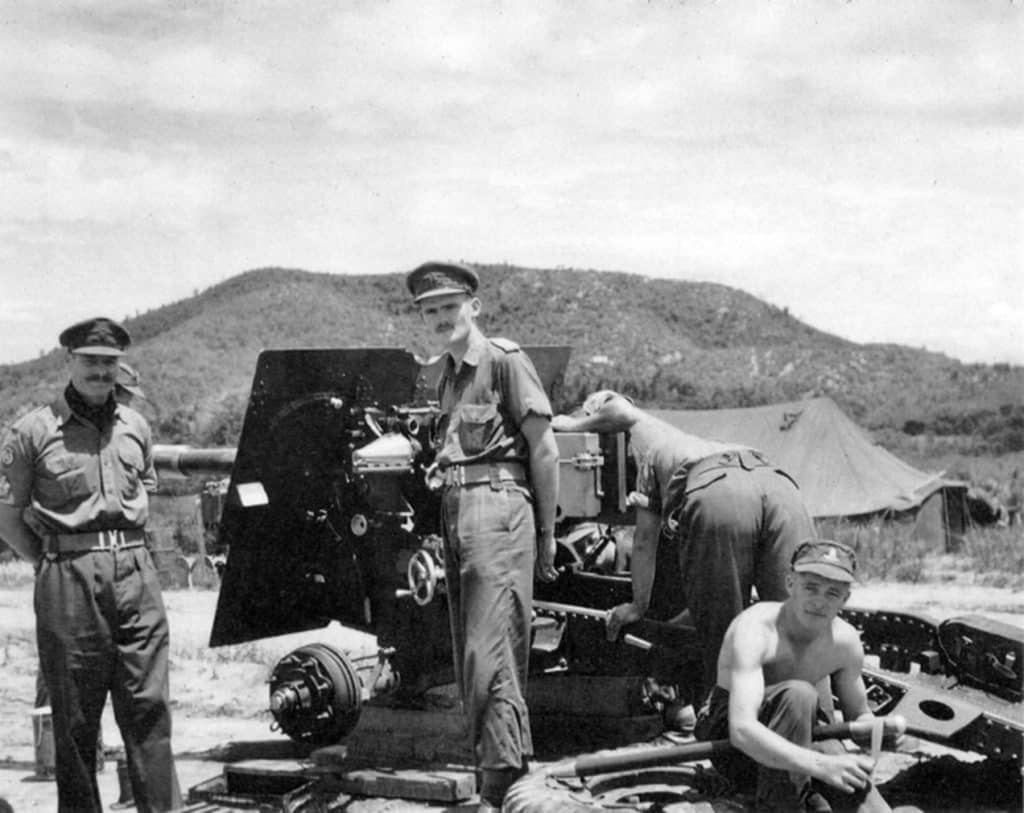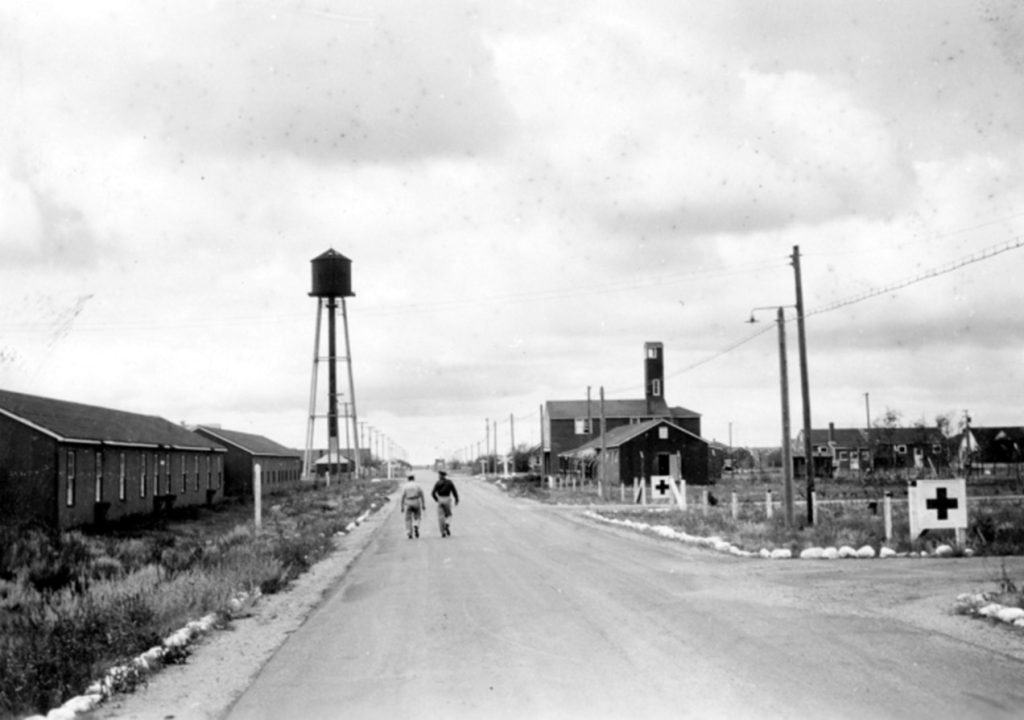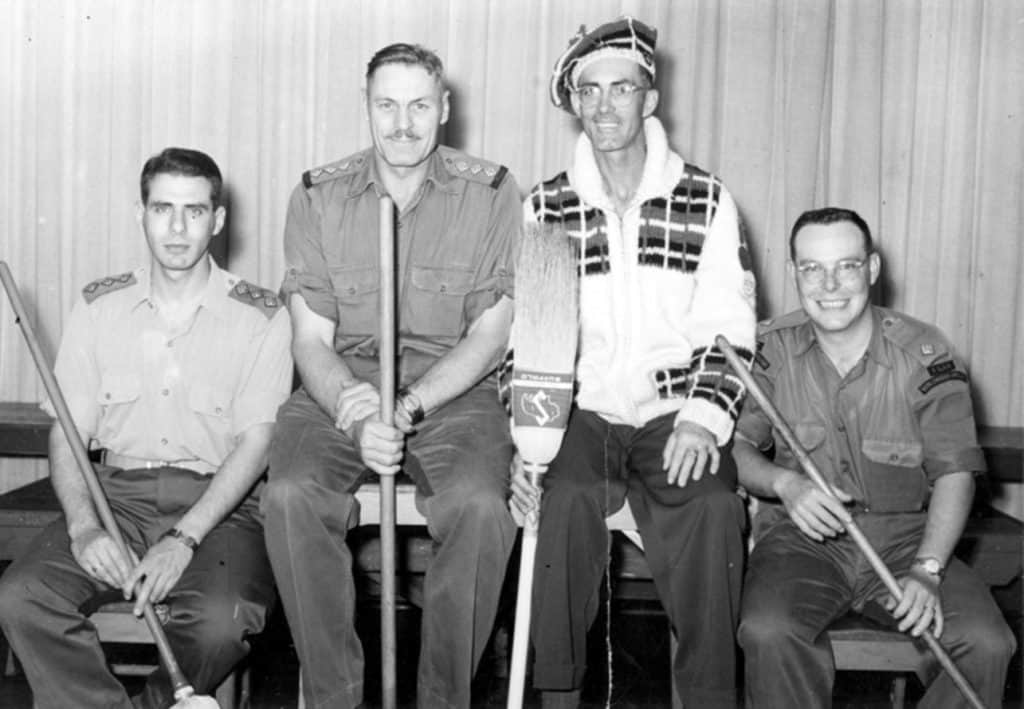The Story of Captain G. R. E. Nicholls
In July 2023, the RCA Museum received an excellent collection from Dr. Janice Nicholls Goerzen, a long-time museum patron. Janice generously donated a fascinating array of over a hundred artifacts that provide a unique glimpse into the life and service of her father, Captain George Robert Edmond Nicholls (1910 – 1987). Captain Nicholls, a WW2 and Korean War veteran, served with the RCA for thirty years, including in Shilo during the 1940s and 1950s. As the child of a serving soldier, Janice and her siblings grew up in Shilo, and many of the artifacts have a Shilo connection.
In 1933, George Nicholls joined C Battery, RCHA, in Winnipeg, Manitoba. When war broke out, Sergeant Nicholls arrived in Britain with the RCHA Brigade, renamed 1st Field Regiment, RCA, in December 1939. Nicholls’ WW2 overseas service was extensive, with deployments to Britain, France, and Germany. After WW2, the Canadian Forces posted him to the 2nd Field Regiment for occupation duties in Germany, and he returned to Canada in June 1946. He spent nearly seven years in Europe, much longer than most Canadian soldiers.
A notable accomplishment, WO2 Nicholls, was one of the first Canadian Gunners to land in France during WW2. In May 1940, Germany launched a massive offensive against France, catching the Allies off guard. On 12 June 1940, the 1st Field Regiment, composed of 311 personnel, including WO2 Nicholls, embarked for France as part of the 2nd British Expeditionary Force.

Gunner Nicholls at Camp Hughes, 1933.

WO Nicholls, 1954.
During the sea voyage, WO2 Nicholls led a 40-man detachment. He wrote, “the loudspeaker aboard on three occasions announced that a ship had been sunk in our convoy by enemy action. It sure upset my men who were down in the hold and scared stiff… I said, ‘I don’t know what you guys are afraid of, but I just want you to know that any boat I ever get on just can’t sink.’” The encouragement did the trick and within 30 minutes the men were on deck talking. They landed at Brest, France 13 June – just as the German Army entered an undefended Paris.
Effectively, France had fallen to the German Army, and on 15 June, British Headquarters ordered the 2nd British Expeditionary Force with the Canadians to return to England. In addition, Headquarters ordered the Canadians to destroy and abandon their newly acquired 25 Pounder Guns. The Commanding Officer, 1st Field Regiment, Lieutenant-Colonel J. H. Roberts, refused and returned to Plymouth, England, with their 24 guns intact on 18 June. The 1st Field Regiment was the only Allied unit to withdraw from France while retaining their guns.
From 1946 to 1958, the CF stationed WO Nicholls primarily at Camp Shilo with his family. After WW2, Nicholls moved to Shilo as an instructor with the Royal Canadian School of Artillery (RCSA). In 1950, he was the RSM at the RCSA. Starting in 1953, he was the RSM with 3 RCHA, including a post-armistice deployment to Korea from April to December 1954. In August 1955, he was commissioned as Captain, and then in 1956, the first Chief Instructor for the Depot Battery in Shilo until 1958.

On the left, WO Nicholls in Korea, 1954.
After WW2, Shilo was a training base and home to many units, including the 1st Field Regiment, RCHA, that trained airborne, field, medium, and anti-tank batteries. Shilo was also home to the Royal Canadian School of Artillery (RCSA), teaching field, medium and anti-tank Gunners. Shilo had other units for electrical and mechanical, engineering, hospital and dental, military police, and supply.
Post-WW2, Shilo was an army town with no municipal authority, run exclusively by the military. Persons living on base were either soldiers, dependents, or civilian employees. The population varied yearly, with three to five thousand inhabitants. The camp was relatively isolated, especially in winter, yet had a full complement of stores and excellent recreational facilities.
By the early 1950s, Shilo was expanding with a permanent married-quarters residential area. There were several messes on the base, canteens, men’s and ladies’ social clubs, and many recreational clubs, including badminton, curling, golf, and tennis. Other sports included baseball, basketball, hockey, soccer, swimming, and rifle shooting. Additionally, the base had many organized and supervised children’s activities, including Boy Scouts and Girl Guides.
In 1958, Captain Nicholls moved the family to Lethbridge, Alberta. He was the Commander of the Instructional Staff, Headquarters, Western Command, No. 10 Personnel Depot. He retired from the Canadian Forces in 1963 and died in 1987.

Photo of WO Nicholls in Shilo, 1946.
Janice saved many of her father’s military artifacts, and our museum will display some of them in the Manitoba Gallery. The collection has artifacts from the 1930s, including bits, spurs, and stirrups for horses from C Battery. Gunners relied on horses to pull the guns until they had trucks in WW2. Other early artifacts include photos of C Battery and a hockey team championship photo from 1936-37.
The collection includes WW2 binoculars, buttons, cap badges, currency, manuals, patches, and photographs. There are unique artifacts, including a 1940s Battery Fund Box or lockbox made in England. Artillery batteries had these lockboxes to store non-public funds for service members. The collection includes many photos taken during WW2 and in Korea during his deployments, a pace stick from the 1940s and a swagger stick from the 1950s.

C Battery Hockey Team, Winnipeg, 1936-37.

Runners-Up, Curling Team, Shilo, 1958.
Janice donated many artifacts with a Shilo connection, including base brochures from the 1940s and 1950s. Our museum did not have any Shilo pamphlets from the 1940s. Other Shilo-related artifacts include buttons, medals, newspapers, sports photos, sweater patches, and trophies.
The collection had Gunner-related items, such as artillery board templates, gun manuals, mortar rounds, and uniform components, such as battle dress pants, belts, coveralls, and neckties. Janice included an 1862 Snider-Enfield Rifle, Mark 1. The Canadian Militia issued this model to troops from the 1860s to 1901, notably during the Fenian Raids (1866 to 1870) and the Red River Expedition (1870). At my request, Janice kindly added her father’s military decorations, which we placed on display in the Manitoba Gallery.
Captain Nicholls spent thirty years in the Canadian Artillery, half his time in Winnipeg and Shilo, and seven years overseas during WW2 and the Korean War. His collection is extensive and significant in scope. We want to share his story in our museum, showcasing his time in Shilo and overseas deployments. We hope the display honourably reflects his service in the RCA and helps tell the story of the Canadian Gunner.
By Andrew Oakden
